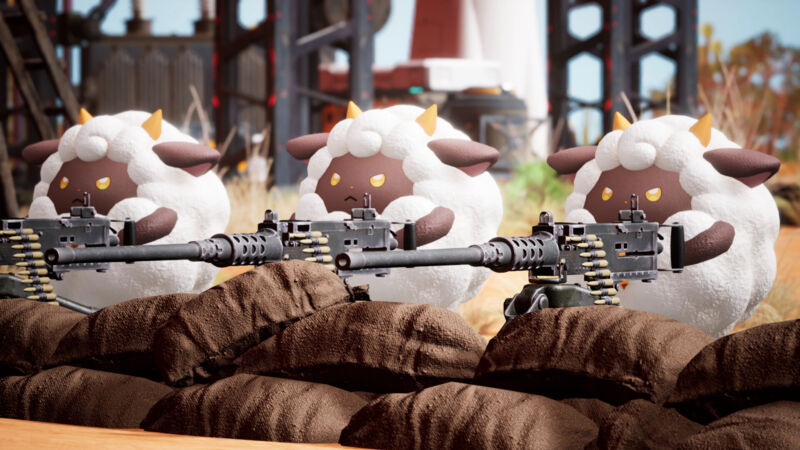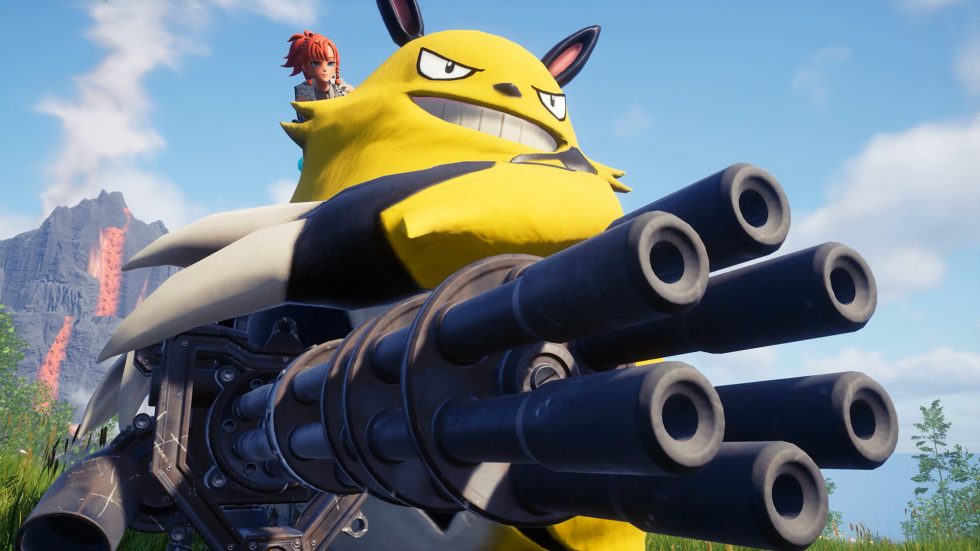Op-ed: Dark comedy is part of the draw, but many want a game with bigger ideas.

I’m whacking at a rock as the sun sets. The game is telling me that I am cold and hungry. But I need to collect enough resources to make a Pal Sphere to catch some Pals so I can assign them to work at my base and gather even more resources.
I am in the very opening minutes of Palworld, a game made by an obscure Japanese indie studio named Pocketpair. Some combination of algorithmic providence and word of mouth helped the game score some impressive achievements in its first Early Access weekend: over 5 million copies sold and nearly 1.3 million concurrent Steam users playing the game, beating out the high-watermarks for big-name games like Cyberpunk 2077, Elden Ring, and Baldur’s Gate 3.
The game’s success means it has already been through multiple cycles of minor Internet controversy, mainly related to circumstantial evidence that its monster designs may have been created by generative AI or from the actual 3D models used in the Pokémon games.
I’m not here to rule one way or the other on this, except to say that I find the accusations of model theft more convincing than the generative AI accusations; making fake monsters in the style of Pokémon has been a pastime for many budding DeviantArt and Tumblr artists for years, long before generative AI could ever have had anything to do with it. Pocketpair CEO Takuro Mizobe has reportedly claimed that the game “has cleared legal reviews.”
- This is Dash Catchem, an original character who is not in any way based on any kind of established IP. Andrew Cunningham
- Pokémon NPCs usually spout empty-headed pleasantries about the wonders of Pokémon; the NPCs in Palworld set a darker tone from the start. Andrew Cunningham
- Yes, you can have pleasant moments, too. Andrew Cunningham
- Climbing up the tech tree so you can build more structures and items is reasonably engaging; some of these things only become unlockable once you’ve caught certain Pals. Andrew Cunningham
- Progression happens on a whole bunch of axes: your personal character level, your Pals’ level, and the level of your base(s). Andrew Cunningham

The secret to Palworld‘s rise may be no more complicated than the three-word summary you’ll see over and over in coverage of it: “Pokémon with guns.” Countless parodies have found humor (and cash) in adding darkness to the bright, sanitized world of kids’ toys and entertainment, from Garbage Pail Kids to the infamously vitriolic and universal campaign against Barney the dinosaur. Entire YouTube channels have been built around doing this to Pokémon and other games.Advertisement
I’ve only played the first few hours of a single-player Palworld campaign, enough to get a handle on the game’s basic mechanics and art style but not much else. It doesn’t seem like it’s doing anything tremendously original or ambitious—it’s built on the kinds of resource-gathering, item-crafting, base-building, and survival gameplay loops that have served as a foundation for countless other games. And whatever you think of the monster designs, the rest of the game’s art has a bland “default game engine asset” look to it. Overall, things work well enough to give the game a busted charm that probably works in its favor rather than against it (see: me holding an axe, my hands clipping through my character’s stomach because the character creator let me make my torso too wide).
The way the base-building parts of the game and the monster-catching parts interact is sort of interesting. As you catch monsters in your Poké balls Pal Spheres, you can carry some with you for battling and exploring à la regular Pokémon game, but you can assign others to work your base, where they’ll build things and perform other duties as directed. Each Pal has a specific set of activities they can perform while assigned to your base, so the more you want to automate, the more kinds of Pals you’ll want to catch, and the more you’ll want to level up your base so more Pals can work there simultaneously.
Come for the darkness, stay for the more interesting gameplay

Palworld will let you get away with things that mainline Pokémon games would never countenance: selling your creatures for money; killing, cooking, and eating them; poaching them from wildlife preserves; and cooking meat from one of them and then feeding it to another member of the same species. You can catch and sell human NPCs. You can work your creatures to death on an assembly line by choosing not to give them food or shelter. “Don’t worry,” the game’s copy assures potential buyers. “There are no labor laws for Pals.”
So, yes, a lot of the game’s notoriety comes from the whole “Pokémon, but dark” thing.
But there’s something else to the game’s success, too—a desire for the Pokémon game franchise to grow up alongside the people who have been playing it.
That’s not to say that recent entries like Scarlet and Violet and (especially) Pokémon Legends: Arceus haven’t had any new ideas. Palworld‘s monster-catching and battling mechanics actually have way more to do with the ones in Arceus than with most other mainline Pokémon games. But the main draw in any given generation is the new monster designs, followed by whatever modest tweaks Game Freak decides to make to the 30-year-old “travel world, catch guys, become Pokémon Master” formula.
- I’d describe the game as “charmingly janky,” like when the character creator lets you make a boy who’s so wide that his arms clip through his stomach when he holds an axe. Andrew Cunningham
- Witness a torrent of water pouring forth from this watering can, which I conjured up from nothing. Andrew Cunningham
- The beginnings of a base, bustling with busy pals. Andrew Cunningham

Survival mechanics in a Pokémon game? Crafting and a tech tree, plus base management and online multiplayer? Open-world exploration with more than a hint of Breath of the Wild‘s influence? More things to do with your monsters that don’t involve catching or battling? You could lose all of the “edgy” trappings, and you’d still have the ingredients for a game that could become a major long-term success.Advertisement
You can see this play out in the Steam reviews. Sure, many people are here to see a machine-gun-toting Pikachu mow down other Pikachu. But a ton of people are also there to voice some kind of discontent with the Pokémon franchise as it currently stands, expressing a desire for a deeper and more communal game.
Don’t get me wrong—people are always complaining about the Pokémon franchise as it currently stands, and it feels like they always have been complaining about it, even as new versions generally manage to become some of the bestselling titles on any given Nintendo console. But this time, I think we can look at the combination of reviews, sales, and active users and see that there is clearly an audience hankering for more radical change.
If hundreds of thousands of people are willing to buy and play this janky, generic-looking, heavily derivative, possibly ethically and legally dubious survival crafting game, there has to be at least some appetite for an official version using the Pokémon franchise’s stable of 1,000-plus catchable creatures. I’m not holding my breath, but it would be nice if someone noticed.




